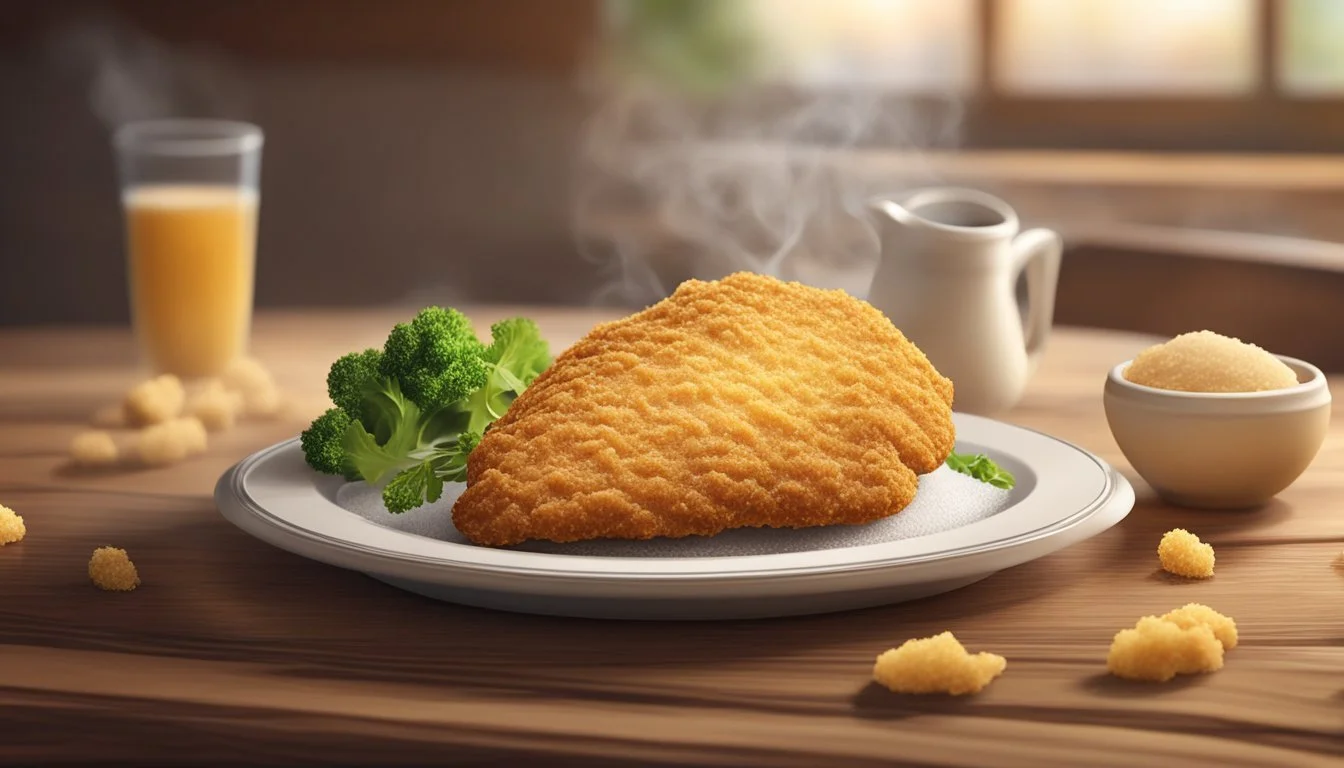How Long Does Gluten-Free Breaded Chicken Breast Last?
Freshness Guide
When it comes to storing gluten-free breaded chicken breast, understanding its shelf life can help prevent food waste and ensure safety. Properly stored in the refrigerator, gluten-free breaded chicken breast can last up to three to four days.
For those looking to keep their chicken longer, freezing is a reliable option. Frozen gluten-free breaded chicken breasts can last up to four months while maintaining their quality. Make sure to use airtight containers or heavy-duty freezer bags to prevent freezer burn.
Extending the life of your gluten-free breaded chicken breast allows for quick meal prepping without compromising on taste or safety. Follow these guidelines to enjoy your meals without worry.
Understanding Gluten-Free Breaded Chicken Breast
Gluten-free breaded chicken breast is a favorite among those with gluten sensitivities. Breading typically involves using gluten-free breadcrumbs or almond flour. Both options ensure a crispy exterior without gluten.
Common Ingredients:
Gluten-free breadcrumbs
Almond flour
Gluten-free all-purpose flour
Egg mixture
Spices (like taco seasoning)
Preparation Steps:
Coat the Chicken: Start by coating the chicken in gluten-free flour, followed by dipping it in a beaten egg mixture.
Add the Breading: Roll the chicken in gluten-free breadcrumbs, almond flour, or a mixture of parmesan and corn flakes.
Cook Properly: Fry or bake at 400°F until golden brown.
Pros of Using Gluten-Free Ingredients:
Safe for those with celiac disease or gluten intolerance.
Options like almond flour add a unique flavor.
Provides a similar texture to traditional breading.
Storage Tips:
Once prepared, store in an airtight container in the refrigerator.
Reheat in the oven to maintain crispiness.
Safety Note: Always check that all ingredients are certified gluten-free to avoid contamination.
Using the above methods ensures a delicious and safe gluten-free breaded chicken breast.
Ingredients and Preparation
The quality and preparation of ingredients are key to making delicious gluten-free breaded chicken. This section covers how to select the best ingredients and the necessary steps for preparation, from coating to frying or baking.
Selecting Quality Ingredients
Choosing high-quality ingredients ensures flavorful and healthful gluten-free breaded chicken. Start with fresh chicken breasts, ideally antibiotic-free and organic. Look for large eggs to help bind the breading to the chicken.
Parmesan cheese adds a savory layer to the breading mixture, and corn flake crumbs or gluten-free breadcrumbs provide a crunchy texture. Opt for extra virgin olive oil, which adds a nuanced flavor, or a neutral oil like canola if you prefer a milder taste.
Seasonings such as salt, black pepper, garlic powder, and Italian seasoning will enhance the flavor. Consider using vegan mayonnaise as an egg substitute if making a vegan version.
Preparing the Chicken
Prepare the chicken by removing any excess fat and moisture with paper towels. Use a sharp knife to slice each chicken breast horizontally, creating thin fillets. This ensures even cooking and a crispy exterior.
Marinate the chicken in a mixture of salt, black pepper, and Italian seasoning for at least 15 minutes in the refrigerator. This step allows the seasoning to penetrate the meat, enhancing the flavor profile. If preferred, add a tablespoon of mayonnaise for extra moisture and a richer taste.
Creating the Breading Mixture
In three separate bowls, prepare the breading station. In the first bowl, combine gluten-free flour, salt, and black pepper. In the second bowl, beat large eggs with a splash of milk to create an egg wash. In the third bowl, mix Parmesan cheese with gluten-free breadcrumbs or corn flake crumbs.
Coat each chicken fillet first in the flour mixture, followed by the egg wash, and finally, roll in the breadcrumb mixture to ensure an even coating. For a lighter option, use vegan mayonnaise instead of eggs.
Preheat your olive oil or neutral oil in a heavy-bottom skillet until hot but not smoking. Fry each fillet for 4-5 minutes on each side until golden brown, or bake in a preheated oven at 400°F for 20-25 minutes, turning halfway through.
Cooking Methods
When preparing gluten-free breaded chicken breast, the method of cooking can significantly impact the food's texture and taste. Here, we break down the key characteristics of baking, frying, and air frying.
Baking in the Oven
Baking gluten-free breaded chicken breast is simple and efficient.
Steps:
Preheat the oven to 425°F (220°C).
Line a baking sheet with parchment paper or use a cooking spray to prevent sticking.
Place the chicken breasts on the sheet, ensuring they are not touching.
Cook Time: Bake for 20-25 minutes, turning the chicken halfway through to ensure even cooking. The internal temperature should reach 165°F (74°C).
Tips:
Use an instant-read thermometer for accuracy.
Brining the chicken beforehand can enhance juiciness.
Frying in Oil
Frying yields a crispy exterior and juicy interior but involves more steps and monitoring.
Steps:
Heat a quarter-inch layer of oil in a skillet over medium-high heat.
When the oil reaches 350°F (175°C), carefully place the chicken breasts in the skillet.
Cook Time: Fry for 4-5 minutes per side. Adjust the heat to avoid burning the coating while ensuring the chicken cooks through.
Tips:
Do not overcrowd the skillet, as this can lower the oil temperature.
Use a splatter screen to minimize mess and oil splashes.
Using an Air Fryer
Air frying offers a healthier alternative by using less oil while retaining crispiness.
Steps:
Preheat the air fryer to 390°F (200°C).
Lightly coat the chicken breasts with cooking spray and place them in the air fryer basket in a single layer.
Cook Time: Air fry for 10-12 minutes, flipping halfway through the process.
Tips:
Check the internal temperature to ensure it reaches 165°F (74°C).
For extra crispiness, lightly spray the chicken with oil halfway through cooking.
By understanding these methods, you can achieve the perfect gluten-free breaded chicken breast for any meal.
Proper Storage Techniques
Proper storage of gluten-free breaded chicken breast is essential to maintain its freshness and prevent spoilage. Key techniques include refrigeration, freezing, and the use of airtight containers, each offering specific benefits for longevity and quality.
Refrigeration
When storing gluten-free breaded chicken in the refrigerator, it is crucial to ensure it is properly cooled before storage. Place it in a shallow container to cool quickly.
Refrigeration Tips:
Store the chicken in a sealed container or wrap it tightly with plastic wrap.
Place it on a shelf in the middle or upper area of the refrigerator, where the temperature is most consistent.
Consume refrigerated breaded chicken within 3-4 days to ensure safety and flavor.
Maintaining a refrigerator temperature of 40°F (4°C) or lower minimizes bacterial growth and keeps the chicken fresh longer. Always check for signs of spoilage, such as an off odor or texture changes, before consuming.
Freezing
Freezing gluten-free breaded chicken is ideal for longer-term storage. Proper initial preparation helps in maintaining taste and quality.
Freezing Tips:
Allow the chicken to cool completely before freezing to avoid ice crystals forming.
Wrap each piece individually in plastic wrap or aluminum foil.
Use airtight freezer bags or containers to prevent freezer burn.
Label each package with the date for easy tracking. Gluten-free breaded chicken can be stored in the freezer for up to 2-3 months. Thaw frozen chicken in the refrigerator for safe defrosting before reheating or cooking.
Using Airtight Containers
Airtight containers are essential for keeping gluten-free breaded chicken fresh, whether refrigerated or frozen. They prevent air and moisture from affecting the food.
Airtight Container Tips:
Opt for containers with a secure, snap-on lid to ensure a tight seal.
Glass or high-quality plastic containers work best for maintaining freshness.
Make sure the containers are clean and dry before use.
For refrigeration, airtight containers help maintain the chicken's texture and flavor. In the freezer, they offer added protection against moisture and ice crystals that can affect the breading quality. Storing breaded chicken properly extends its shelf life and keeps it safe to eat.






